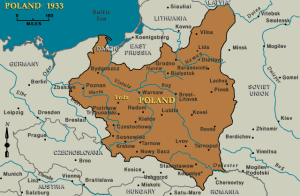 Poland’s geographic position between Germany and Russia seems the ultimate definition of being squeezed between a rock and a hard place. In the 1930’s, the game became decidedly lethal when Hitler represented the rock, and Stalin the hard place.
Poland’s geographic position between Germany and Russia seems the ultimate definition of being squeezed between a rock and a hard place. In the 1930’s, the game became decidedly lethal when Hitler represented the rock, and Stalin the hard place.
Colonel Józef Beck, who conducted Polish foreign policy between 1932 and 1939 clearly understood that strategically Poland had nothing to offer diplomatically to outside powers – no dependable allies, crucial resources or critical geographic position. In 1932 Poland signed a non-aggression pact with the Soviet Union. Both the Soviet Union and Poland were weak countries at the time. But the Soviet Union gained the most from the treaty. Poland, fearful of being ‘unfriendly’ never publicized its knowledge of the huge famine of 1932-33 created by Stalin’s collectivization. Current estimates place the death toll at 5-10 million for that famine alone. Consequently the international community remained unimpressed with Poland and ignorant of Stalin’s harsh policies. In 1933 the United States extended diplomatic recognition to the Soviet Union. For the next decade Stalin was seen as a power to deal with to maintain peace, or at least to avoid another world war. Poland became the bargaining chip of other countries.
The pact with the Soviets also angered Germany. In 1933 Hitler came to power in Germany, and in a conciliatory move, Poland and Germany signed a non-aggression pact in 1934. Poles knew better than to trust Russians, so their best hope was to placate Germany. The pact with Germany drew strong international criticism and angered France, who had signed a treaty with Poland to the effect that an unprovoked attack on one country by Germany – would mean the other declared war; though it appears France was pre-occupied with its own issues. In negotiating the pact with Poland, it could be said Hitler simply bought time to fortify for the future.
Polish joke: It’s 1939, and a Polish peasant sits in a hut with two doors, one facing west to Germany and one facing east to Russia. He has a gun with only two bullets. The doors both burst open at the same time – Nazi to the west, Russian to the east. Who does he shoot first? (When told this I guessed the Russian because Poles hate Russians. I was wrong.)
The answer: he shoots the German first. Why? Business before pleasure.
Photo courtesy ushmm.org; Also notice the northern seaport of Danzig. Danzig was desired by both Germany and Poland as a critical seaport; prior to Polish independence Danzig belonged to Germany. They wanted it back. Today the city is known by its Polish name, Gdansk.
Sources: Zamoyski; Kochanski, The Eagle Unbowed.
